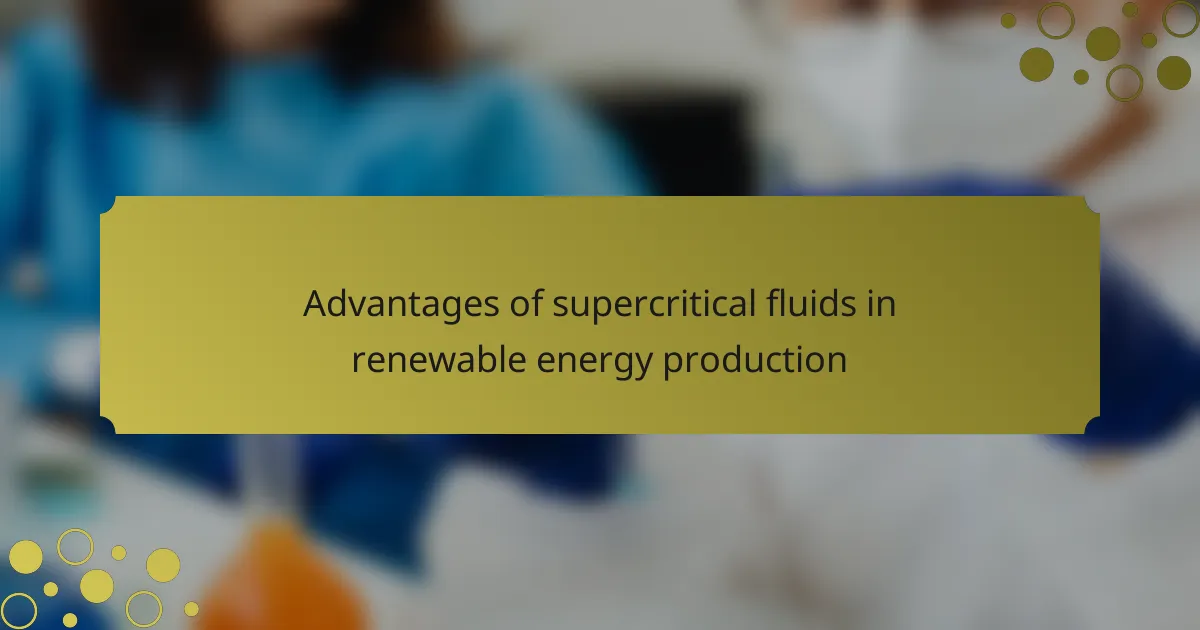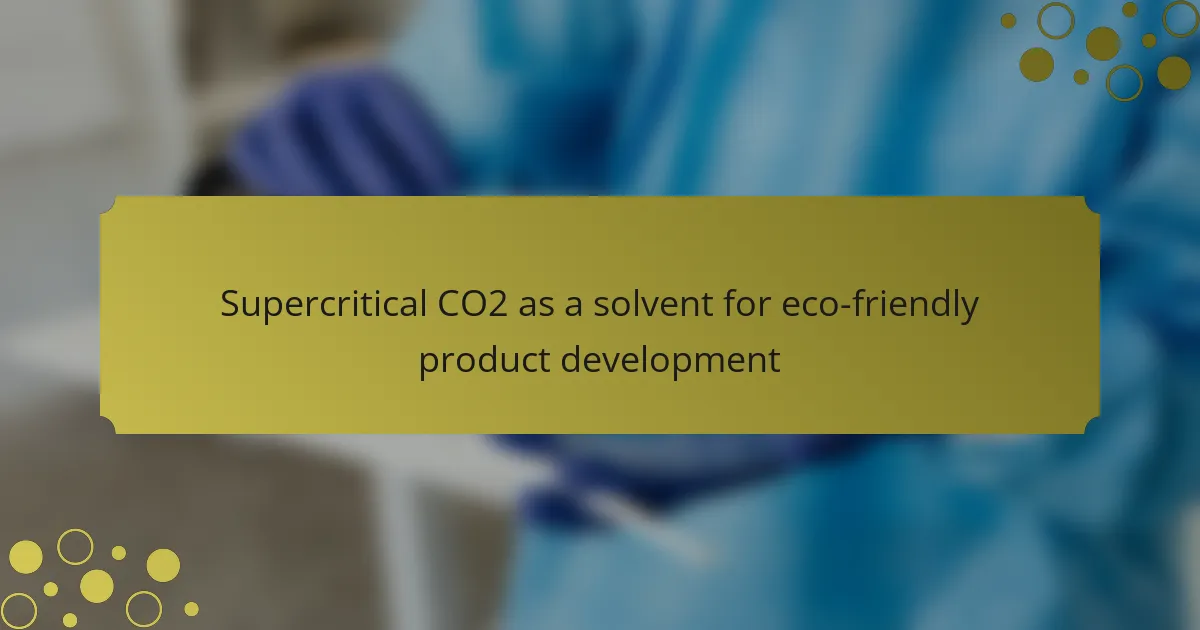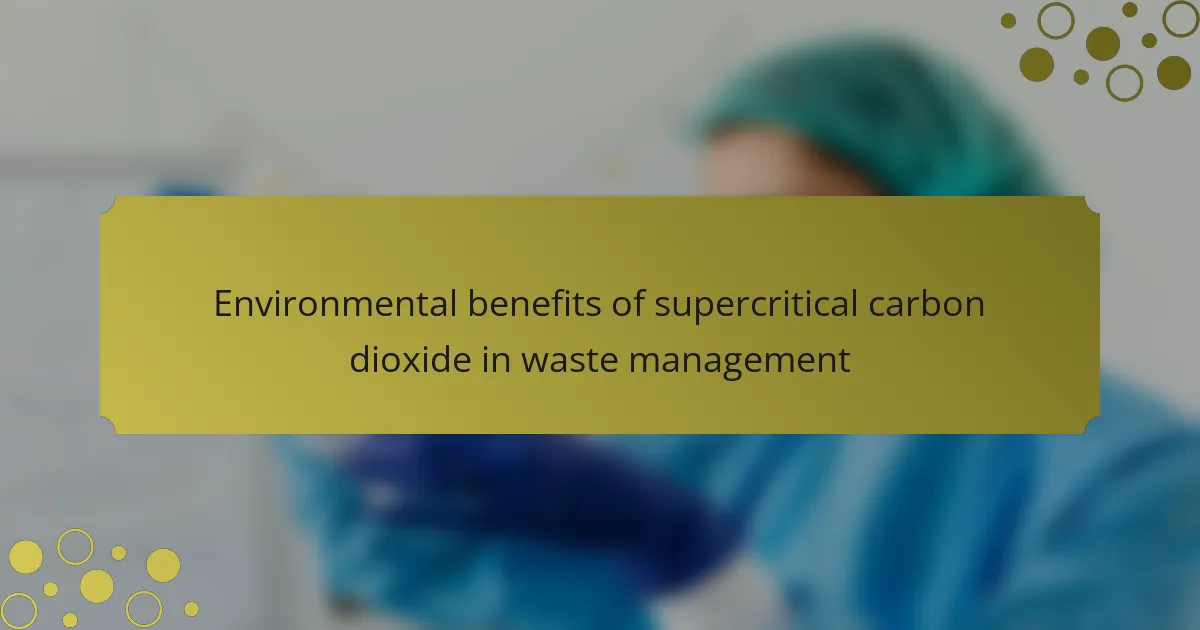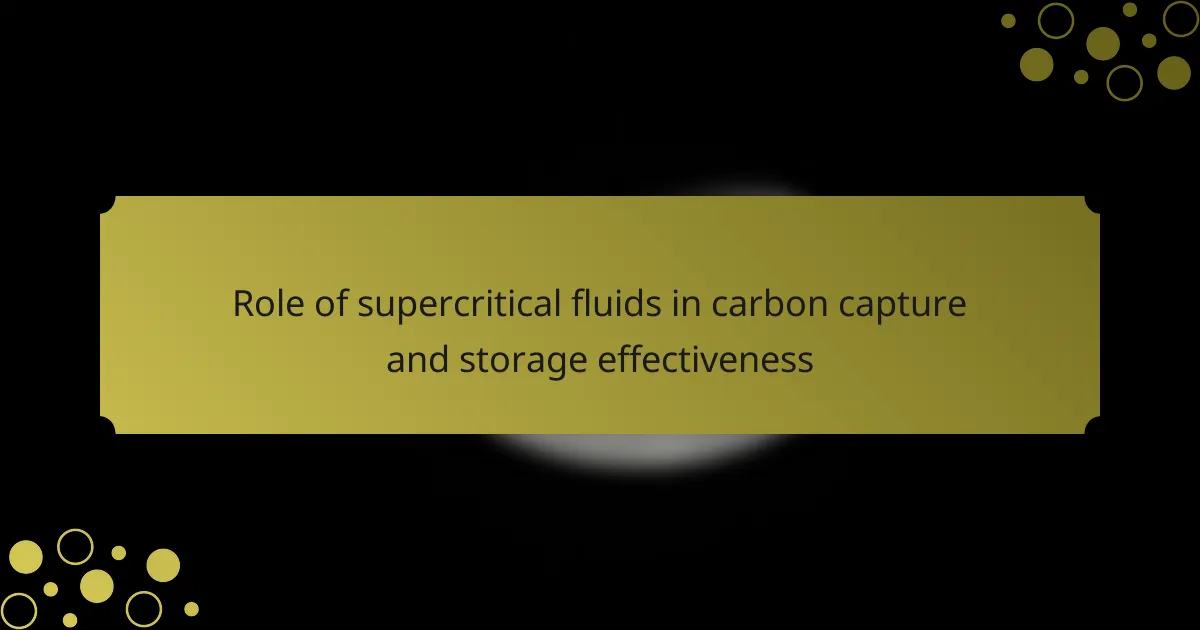Supercritical fluid extraction (SFE) is a separation process that utilizes supercritical fluids, primarily carbon dioxide, to efficiently extract compounds from solid or liquid materials. This method is notable for its environmental benefits, as it significantly reduces the use of harmful solvents associated with traditional extraction techniques, resulting in less toxic waste. Research indicates that SFE not only maintains or enhances extraction efficiencies compared to conventional methods but also aligns with stricter environmental regulations. The article will explore how SFE contributes to sustainability efforts by minimizing hazardous waste generation and promoting eco-friendly practices in various industries.
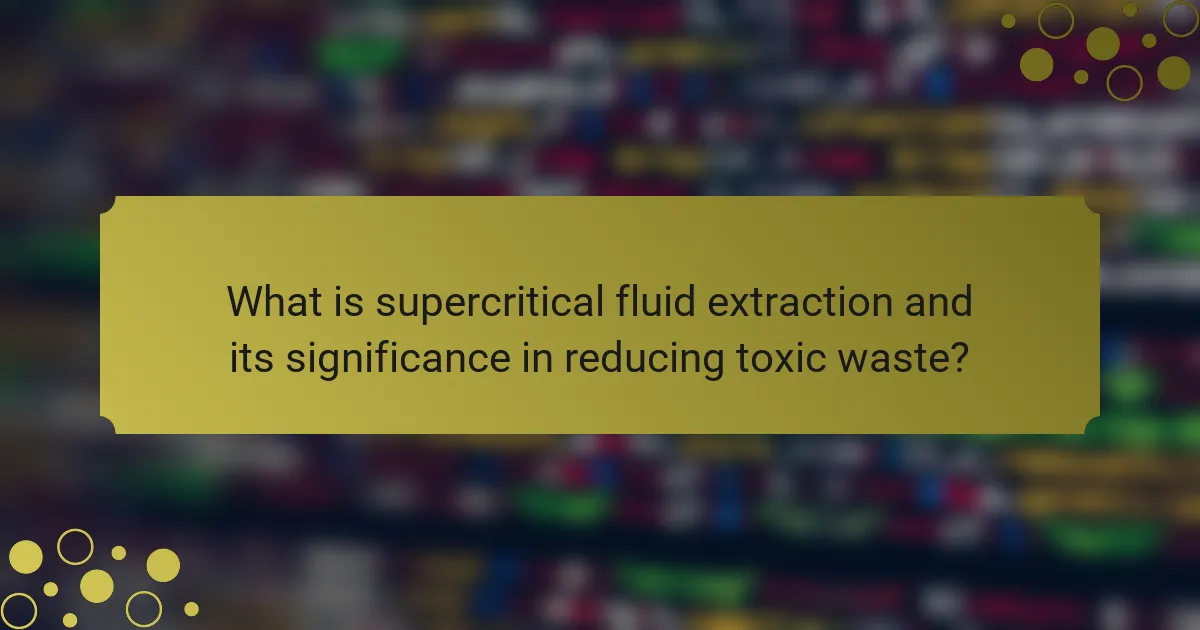
What is supercritical fluid extraction and its significance in reducing toxic waste?
Supercritical fluid extraction (SFE) is a separation process that uses supercritical fluids to extract compounds from solid or liquid materials. It typically employs carbon dioxide as the supercritical fluid due to its low toxicity and ability to dissolve a wide range of substances. SFE is significant in reducing toxic waste because it minimizes the use of harmful solvents commonly used in traditional extraction methods. This process generates less hazardous waste, making it more environmentally friendly. Studies have shown that SFE can achieve similar or higher extraction efficiencies compared to conventional methods while producing fewer pollutants. By utilizing supercritical fluids, industries can comply with stricter environmental regulations and contribute to sustainability efforts.
How does supercritical fluid extraction work?
Supercritical fluid extraction (SFE) uses supercritical fluids to extract compounds from solid or liquid materials. A supercritical fluid is a substance at a temperature and pressure above its critical point. This state allows the fluid to exhibit properties of both gases and liquids. In SFE, carbon dioxide is commonly used due to its non-toxic nature and ability to dissolve a wide range of compounds.
The process begins by placing the material to be extracted in a chamber. The supercritical fluid is then introduced into the chamber under controlled temperature and pressure. As the supercritical fluid passes through the material, it dissolves the desired compounds.
Once the extraction is complete, the pressure is reduced. This causes the supercritical fluid to revert to a gaseous state, leaving the extracted compounds behind. This method is efficient and minimizes the use of harmful solvents, thus reducing toxic waste. Studies have shown that SFE can significantly lower the environmental impact associated with traditional extraction methods.
What are the key components of supercritical fluid extraction?
The key components of supercritical fluid extraction (SFE) are the supercritical fluid, extraction vessel, and separation unit. The supercritical fluid, often carbon dioxide, acts as the solvent. It has unique properties that allow it to dissolve both polar and non-polar compounds. The extraction vessel is where the material to be extracted is placed. This vessel maintains the necessary temperature and pressure for the supercritical fluid to operate effectively. The separation unit is responsible for isolating the extracted compounds from the supercritical fluid after extraction. This process minimizes the use of organic solvents, thus reducing toxic waste. Studies indicate that SFE can cut solvent waste by up to 90% compared to traditional extraction methods.
How does the supercritical state influence extraction efficiency?
The supercritical state significantly enhances extraction efficiency. In this state, fluids exhibit unique properties that combine gas and liquid characteristics. This allows for better solvation of compounds, leading to higher extraction yields. Supercritical fluids, like carbon dioxide, can penetrate materials more effectively than traditional solvents. Additionally, they have tunable densities, which can optimize the extraction process for specific compounds. Research indicates that supercritical fluid extraction can achieve extraction efficiencies up to 90% or higher, compared to lower efficiencies with conventional methods. This efficiency is crucial in reducing toxic waste by minimizing the need for harmful solvents.
What are the environmental impacts of traditional extraction methods?
Traditional extraction methods often lead to significant environmental impacts. These methods can result in habitat destruction due to land clearing for extraction sites. Soil degradation occurs from the removal of vegetation and topsoil. Water pollution is common as chemicals used in extraction can leach into nearby water sources. Air pollution can arise from emissions associated with machinery and transport. Additionally, traditional methods often generate large amounts of waste, contributing to landfill issues. According to the United Nations Environment Programme, traditional extraction can lead to biodiversity loss, affecting ecosystems and species.
How do traditional methods contribute to toxic waste generation?
Traditional methods contribute to toxic waste generation through inefficient extraction processes. These methods often use harmful solvents and chemicals. For instance, organic solvents can lead to significant chemical waste. The disposal of these solvents can contaminate soil and water sources. Additionally, traditional methods typically have lower extraction efficiencies. This inefficiency results in larger quantities of raw materials being processed. Consequently, more waste is generated during the extraction process. Studies show that conventional extraction can produce up to 90% waste in some cases. This highlights the environmental impact of traditional extraction techniques.
What are the ecological consequences of toxic waste?
Toxic waste has severe ecological consequences. It contaminates soil, water, and air. This contamination disrupts ecosystems and harms wildlife. Species exposed to toxic waste may suffer from health issues or die. Polluted water bodies can lead to fish kills and loss of biodiversity. Soil contamination affects plant growth and agricultural productivity. Bioaccumulation of toxins in food chains poses risks to human health. The long-term effects can result in irreversible damage to natural habitats.
What advantages does supercritical fluid extraction offer over traditional methods?
Supercritical fluid extraction (SFE) offers several advantages over traditional methods. SFE utilizes supercritical fluids, typically carbon dioxide, which are non-toxic and environmentally friendly. This method reduces the use of harmful solvents, thereby minimizing toxic waste generation. SFE achieves higher extraction efficiency due to better solvation properties of supercritical fluids. It allows for selective extraction, preserving sensitive compounds and enhancing product quality. Additionally, SFE operates at lower temperatures, which helps maintain the integrity of heat-sensitive materials. Studies indicate that SFE can significantly lower solvent consumption compared to conventional methods, supporting sustainability.
How does supercritical fluid extraction minimize toxic waste production?
Supercritical fluid extraction minimizes toxic waste production by utilizing carbon dioxide as a solvent. This method reduces the use of harmful organic solvents, which are often associated with toxic waste. Supercritical CO2 is non-toxic, recyclable, and leaves no harmful residues. The extraction process operates at lower temperatures, preserving the integrity of sensitive compounds. Additionally, supercritical fluid extraction can be highly selective, targeting specific compounds and reducing the need for additional purification steps. Studies show that it generates significantly less waste compared to traditional extraction methods. For instance, a comparison indicated a reduction in solvent waste by up to 90%.
What are the benefits of using supercritical fluids in various industries?
Supercritical fluids offer numerous benefits across various industries. They provide enhanced extraction efficiency, allowing for better yields of desired compounds. This is particularly valuable in the food and pharmaceutical sectors, where purity is crucial. Supercritical fluids also operate at lower temperatures, preserving sensitive compounds that could degrade at higher temperatures.
Additionally, they are environmentally friendly, as they often replace toxic solvents with non-toxic alternatives. This reduces the overall toxic waste generated in industrial processes. For example, supercritical CO2 is widely used for extracting essential oils and flavors, minimizing chemical residues.
Moreover, supercritical fluid technology can lead to cost savings by reducing solvent recovery and disposal costs. Industries utilizing supercritical fluids can achieve higher product quality and sustainability. These factors contribute to their growing adoption in sectors such as cosmetics, food processing, and materials science.
How does supercritical fluid extraction compare to other green technologies?
Supercritical fluid extraction (SFE) is often regarded as a superior green technology compared to others. SFE utilizes supercritical CO2, which is non-toxic and environmentally friendly. This method reduces the use of harmful solvents typically found in conventional extraction processes. Studies show that SFE can achieve higher extraction efficiencies while minimizing waste production. For instance, SFE can extract compounds at lower temperatures, preserving sensitive materials and reducing energy consumption. Additionally, SFE generates less hazardous waste compared to traditional methods, aligning with green chemistry principles. Overall, SFE not only enhances extraction quality but also significantly lowers environmental impact.
What are the unique attributes of supercritical fluid extraction?
Supercritical fluid extraction (SFE) has several unique attributes. It utilizes supercritical fluids, typically carbon dioxide, to extract compounds. This method operates at elevated temperature and pressure. SFE allows selective extraction of specific compounds. It reduces the need for harmful solvents. The process is efficient and environmentally friendly. SFE can be easily scaled for industrial applications. It often results in higher purity extracts compared to traditional methods. These attributes contribute to minimizing toxic waste in extraction processes.
How does it integrate with other sustainable practices?
Supercritical fluid extraction (SFE) integrates with other sustainable practices by minimizing the use of harmful solvents. It utilizes carbon dioxide as a solvent, which is non-toxic and environmentally friendly. This method significantly reduces the generation of hazardous waste compared to traditional extraction methods. According to a study published in the Journal of Cleaner Production, SFE can decrease solvent waste by up to 90%. Additionally, SFE enhances energy efficiency, as it operates at lower temperatures and pressures, further reducing its environmental impact. This alignment with sustainable practices promotes a circular economy by facilitating the recovery of valuable compounds while minimizing ecological footprints.
What are the future prospects for supercritical fluid extraction in waste reduction?
Supercritical fluid extraction (SFE) has promising future prospects in waste reduction. SFE utilizes supercritical fluids to extract valuable compounds from waste materials. This method minimizes solvent usage and reduces hazardous waste generation. Research indicates that SFE can efficiently recover bioactive compounds from agricultural waste. A study by Ghafoor et al. (2021) demonstrated SFE’s effectiveness in extracting antioxidants from fruit peels, significantly reducing waste. Additionally, SFE can enhance the recycling of materials by extracting valuable components from electronic waste. The increasing focus on sustainability and circular economy principles further supports SFE’s role in waste management. As technology advances, SFE is expected to become more cost-effective and widely adopted in various industries.
How can advancements in technology enhance its effectiveness?
Advancements in technology can enhance the effectiveness of supercritical fluid extraction (SFE) by improving extraction efficiency and reducing processing time. Enhanced equipment designs allow for better control of temperature and pressure. This results in a more selective extraction of desired compounds. Improved technologies also lead to reduced solvent consumption, minimizing environmental impact. Automation and real-time monitoring increase operational precision and consistency. Research shows that these advancements can lead to up to 30% higher yields compared to traditional methods. Additionally, the integration of machine learning can optimize extraction parameters dynamically. These improvements collectively contribute to more sustainable and effective waste reduction processes.
What role will regulations play in the adoption of supercritical fluid extraction?
Regulations will play a crucial role in the adoption of supercritical fluid extraction (SFE). They will establish safety standards and operational guidelines for the technology. These regulations can incentivize companies to adopt SFE through compliance benefits. Additionally, regulations can promote environmental sustainability by limiting harmful extraction methods. Research indicates that regulated industries are more likely to invest in cleaner technologies. The European Union has implemented regulations that support the use of SFE in food and pharmaceutical sectors. Compliance with these regulations can enhance product quality and safety. Overall, regulations will drive the adoption of SFE by ensuring safety and promoting sustainable practices.
What best practices should be followed when implementing supercritical fluid extraction?
Use high-quality solvents for supercritical fluid extraction. This ensures efficiency and purity in the extraction process. Maintain precise temperature and pressure control during extraction. Optimal conditions enhance yield and quality of the extract. Regularly calibrate equipment to ensure accuracy. Proper calibration minimizes errors and improves reproducibility. Implement thorough cleaning protocols for equipment between extractions. This prevents cross-contamination and maintains product integrity. Conduct pilot studies to optimize parameters before full-scale operations. Pilot studies provide insights into the best conditions for extraction. Monitor and document all extraction parameters meticulously. Documentation aids in troubleshooting and process optimization.
How can operators ensure maximum efficiency and minimal waste?
Operators can ensure maximum efficiency and minimal waste by optimizing supercritical fluid extraction (SFE) parameters. Adjusting temperature and pressure can enhance extraction yields while reducing solvent usage. Implementing real-time monitoring of the extraction process allows for immediate adjustments to maintain optimal conditions. Training staff on best practices in SFE can lead to better operational decisions. Regular maintenance of extraction equipment prevents inefficiencies caused by mechanical issues. Studies show that optimized SFE can reduce solvent waste by up to 90% compared to traditional methods. This reduction not only minimizes environmental impact but also lowers operational costs.
What common challenges might arise, and how can they be addressed?
Common challenges in supercritical fluid extraction (SFE) include equipment cost, operational complexity, and selectivity issues. High initial investment in SFE technology can deter adoption. This can be addressed through financial incentives and grants to support research and development. Operational complexity arises due to the need for precise control of temperature and pressure. Training programs for operators can mitigate this challenge. Selectivity issues occur when unwanted compounds are extracted alongside target substances. Optimization of extraction parameters can enhance selectivity. Additionally, the scalability of SFE processes may pose challenges for large-scale applications. Pilot studies can help in assessing scalability before full implementation.
Supercritical fluid extraction (SFE) is a process that utilizes supercritical fluids, primarily carbon dioxide, to extract compounds from materials while significantly reducing toxic waste. The article explores the operational mechanics of SFE, its advantages over traditional extraction methods, and its environmental benefits, including lower solvent usage and reduced hazardous waste generation. It also addresses the ecological consequences of traditional methods, the future prospects of SFE in waste reduction, and best practices for implementation. Overall, the content highlights SFE’s role in promoting sustainability across various industries by minimizing the environmental impact associated with extraction processes.
